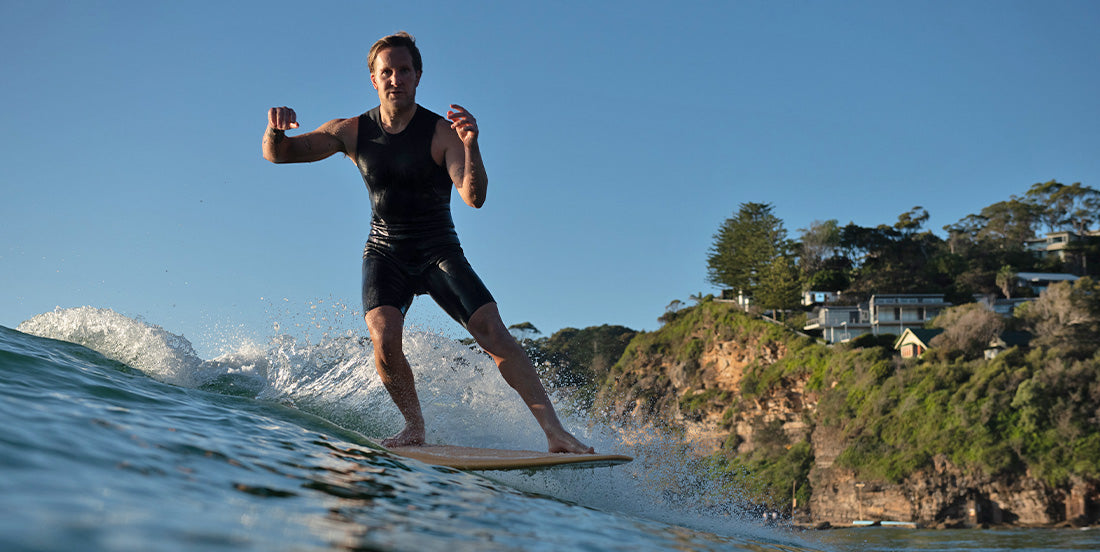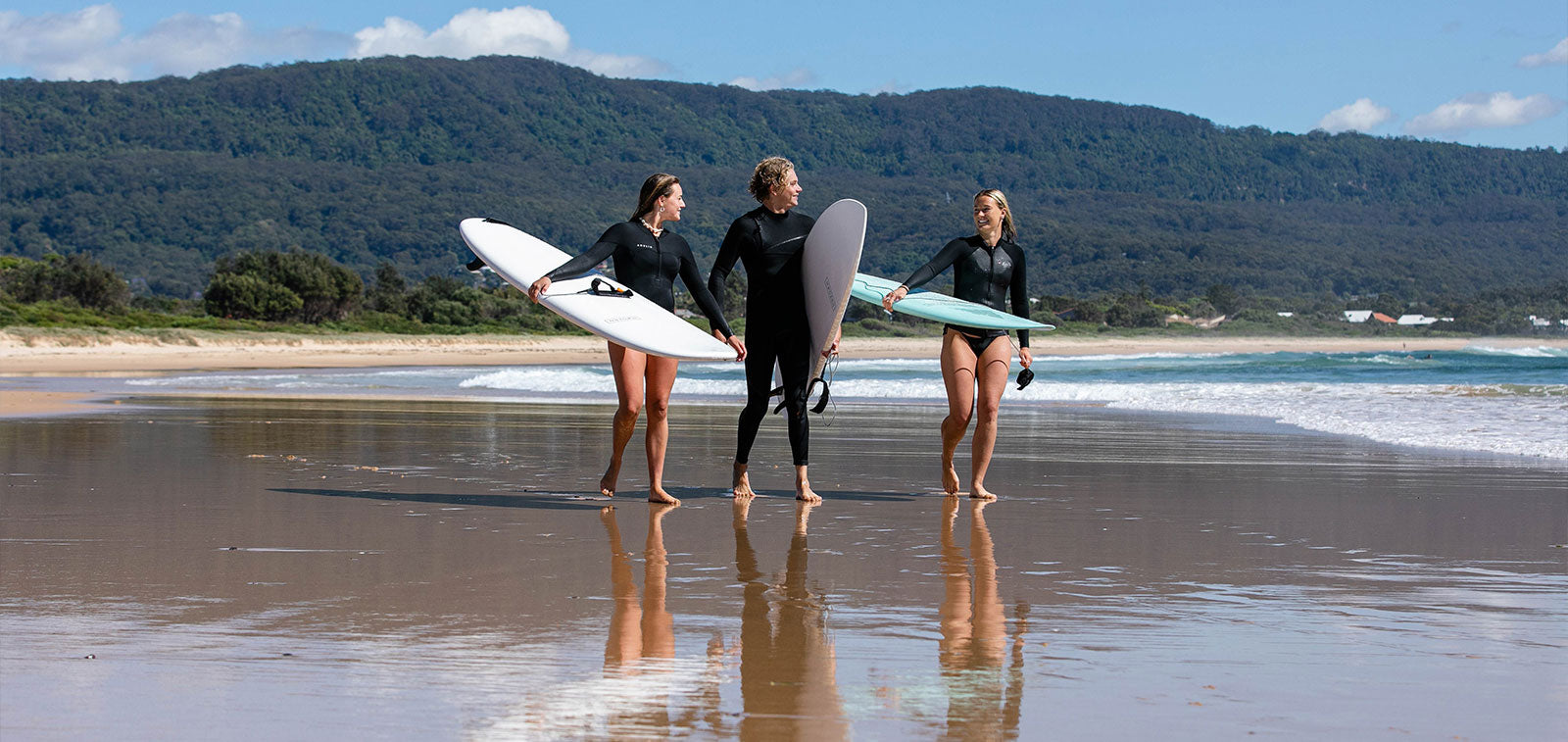
6 Tips for Longboard surfing to help you get from Beginner to Intermediate level
Share
When it comes to longboard surfing there are some key elements where you can gain a lot of confidence that will help your longboarding develop quickly. While these tips may not instantly turn you into a pro cross-stepper, they will undoubtedly provide you with a solid foundation to build upon. Let's jump right into your journey to becoming a skilled longboard surfer by exploring these fantastic tips.
Tip #1: Before you get in the water.
When we talk about the fundamental surf tips, one technique that absolutely deserves focus is the popup. Just in case you're not familiar with it, the popup refers to the graceful movement that transitions you from a lying down to an upright stance on your surfboard. Mastering a solid popup technique can truly make a world of difference between catching your first exhilarating wave and experiencing a rather epic wipeout. So, if you're determined to make the most out of your longboard surfing experience, it's crucial to nail your popup technique. The best part is, it's much easier than you might imagine, especially since you can practice this skill on dry land.

Here’s how to do it.
- Find a comfortable spot on your yoga mat, towel, or even a patch of lush grass.
- Position your hands, palms facing down, in line with your ribs.
- Gently extend your arms to assume the upward dog yoga pose.
- Now, bring your back foot (left for goofy stance/right for regular stance) to the tail area of your longboard.
- As you prepare to rise, use your hands and back foot to create some space between your body and the board.
- As gracefully and smoothly as you can swing your front foot (right for goofy stance/left for regular stance) through the arch between your arms, all while keeping your hips low.
- Feel your center of balance and gradually raise your head and shoulders, maintaining a slight bend in your knees and keeping your lower back nicely aligned.
- Now do this 10 times until it feels comfortable, practice every day for a week if you can.
- Then before your next 5 surf sessions do this 5 times before you leave home.
You will be amazed at what a bit of muscle memory does for your pop up.
Tip #2: Location, location, location
When it comes to longboard surfing, the conditions you choose to ride in can make all the difference in your performance, and it's a tip that's often overlooked. Even if you're a confident beginner or intermediate surfer who has had a few lessons, less-than-ideal conditions can be challenging and detract from your progression. On the flip side, if you find yourself in just the right wave conditions, your confidence will explode.
 That's why we strongly recommend seeking out waves that are longboard-friendly. These are waves that gracefully roll towards the beach, creating a gentle peel or a soft wall of whitewash that can be ridden. On the other hand, we advise against riding waves that crash directly on the shore, break onto shallow sandbanks, or are overcrowded with other surfers. We'll dive deeper into this topic shortly.
That's why we strongly recommend seeking out waves that are longboard-friendly. These are waves that gracefully roll towards the beach, creating a gentle peel or a soft wall of whitewash that can be ridden. On the other hand, we advise against riding waves that crash directly on the shore, break onto shallow sandbanks, or are overcrowded with other surfers. We'll dive deeper into this topic shortly.
Remember, it's essential to exercise caution regardless of the size of the board you're riding. If the conditions appear sketchy or there are no other surfers in the water, it might be wise to wait it out and get a better understanding of the conditions before jumping in. Your safety and enjoyment are key priorities.
Tip #3: Steer clear of the crowd.
When the waves are small, you'll often find more people in the water. Interestingly, these smaller waves provide the perfect opportunity for you to practice your longboard style. However, based on our experience, crowded lineups with varying skill levels can lead to embarrassing and potentially dangerous situations. Work hard to make sure you are not inadvertently dropping in on others, it’s easy for collisions that could damage both boards and bodies.
 Our advice is to avoid adding to the chaos unless you have the guidance of an experienced coach or guide. If there's only one surf spot available on the entire beach, it's still advisable to keep your distance from the main group. Instead of paddling straight through the lineup, opt to paddle around it and position yourself slightly wider from the peak. Even better, if there are multiple options along the beach, take the time to scout for a more relaxed and mellow spot to surf. Being cautious will lead to a more enjoyable less stressful experience.
Our advice is to avoid adding to the chaos unless you have the guidance of an experienced coach or guide. If there's only one surf spot available on the entire beach, it's still advisable to keep your distance from the main group. Instead of paddling straight through the lineup, opt to paddle around it and position yourself slightly wider from the peak. Even better, if there are multiple options along the beach, take the time to scout for a more relaxed and mellow spot to surf. Being cautious will lead to a more enjoyable less stressful experience.
Tip #4: Once you are standing.
Once you pop up you will be standing on your surfboard, it's natural to want to lower your body to improve your balance. However, what doesn't work so well is bending at the waist to achieve that lower position. This can become a bad habit actually disrupts your sense of balance and should be corrected as soon as you become aware of it.
Instead, always remember to bend at the knees and keep your lower body compressed. Whether you're cruising straight on your longboard or attempting a turn, bending at the knees is key to maintaining stability and reducing the likelihood of falling.

For any kind of turn, even the slightest one, focus your gaze on where you want to go. Rotate your hips and apply pressure to either your toe side or your heel side, depending on the direction you want to steer. It's understandable that as a new longboard surfer, you may initially overlook this tip since your balance while cruising straight isn't fully tested. However, as you progress and become more interested in making directional changes and maneuvers, keep in mind the importance of shoulder-width foot placement. Both your rear foot and front foot should be positioned forward over the stringer.
From there, simply maintain those bent knees, control your board by fixing your gaze on your desired path, and let your hips and lower body naturally follow that line.
Tip #5: Get a friend to film you?
 What is going on in your mind and what is going on in reality can do two different things sometimes. Once of the best ways to see what you are doing is to get a friend to film you as you paddle, pop up and then catch the wave. You will be able to see your progression and be able to pick out what you are doing well and not so well pretty easily.
What is going on in your mind and what is going on in reality can do two different things sometimes. Once of the best ways to see what you are doing is to get a friend to film you as you paddle, pop up and then catch the wave. You will be able to see your progression and be able to pick out what you are doing well and not so well pretty easily.
You will be able to get a much better sense of what you need to do. We find this really empowering.
Tip #6: Book a session at a Wave Pool
Wave pools are relatively new on the surfing scene. From our experience they are a lot of fun and a great place to learn and develop your skills. The waves are consistent, there isn’t a crowd to compete with. It’s sort of like a golf driving range where you can get 15 – 20 waves in an hour which is pretty much unheard of in the ocean.
Wave pools offer a great value proposition in getting to the next level quickly. From our experience it’s a fun environment to learn.
Check out the GSI range of Longboard here

